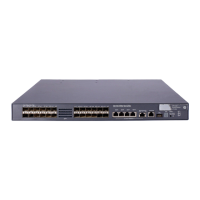41
Meanwhile, the system with the higher system ID, being aware of the aggregation state changes on the
remote system, sets the aggregation state of local member ports the same as their peer ports.
To ensure stable aggregation state and service continuity, do not change port attributes or class-two
configurations on any member port.
In a dynamic aggregation group, when the aggregation state of a local port changes, the aggregation
state of the peer port also changes.
A port that joins a dynamic aggregation group after the selected port limit has been reached will be
placed in the selected state if it is more eligible for being selected than a current member port.
Load sharing criteria for link aggregation groups
In a link aggregation group, traffic may be load-shared across the selected member ports based on a set
of criteria, depending on your configuration.
Choose one of the following criteria or any combination of them for load sharing:
• MAC addresses
• IP addresses
• Service port numbers
• Receiving port numbers
Ethernet link aggregation configuration task list
Complete the following tasks to configure Ethernet link aggregation:
Task Remarks
Configuring a static aggregation group
Configuring an
aggregation
group
Configuring a dynamic aggregation group
Select either task
Configuring the description of an aggregate interface Optional
Enabling link state traps for an aggregate interface Optional
Setting the minimum number of selected ports for an
aggregation group
Optional
Shutting down an aggregate interface Optional
Configuring an
aggregate
interface
Restoring the default settings for an aggregate interface Optional
Configuring load sharing for link aggregation groups Optional
Enabling link-aggregation traffic redirection Optional
Configuring an aggregation group
CAUTION:
Removing an aggregate interface also removes the corresponding aggregation group. At the same
time, all member ports leave the aggregation group.

